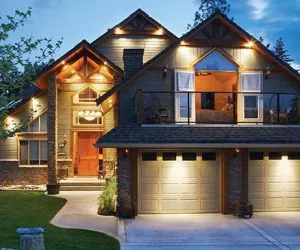
Is the garage you are building well‑lit for all those projects you plan to do? Or, do you already have a garage where the lighting really isn’t sufficient? Illuminating your garage can be easy when you know exactly what types of lighting you need. Here are some tips for lighting up your space.
Start with a Plan
If you’re building a new garage, you have a great opportunity to create a plan for your lighting. If you’re overhauling your existing garage, it’s still good to start with a plan. Sketch out where you plan to set up workspaces and other places where lighting is important. Don’t forget to include:
- The workbench where you’ll do all your DIY projects.
- The storage area for all your seasonal décor and other items.
- The empty wall space where you’ll hang tools and other items.
- The places where you’ll put appliances like your freezer or other large items.
It’s also important to consider the vertical space in your garage. If the ceiling is high, think about how you could use the space just above the garage door. Plastic storage containers on shallow shelves will easily hold items you can’t part with.
Once you’ve determined the overall space of your garage in 3D, you can figure out exactly where you might need to put lighting, and how strong your lighting needs to be in each area.
Available Lighting Types
The market has several types of lighting available for your garage. Those include:
- Fluorescent
Fluorescent light bulbs are those tubular bulbs that are most commonly seen mounted to a ceiling in a garage. The atoms of the mercury vapor inside the bulb is ionized, which is what produces the light. Phosphor coating inside the tube will color the light.
- CFL, or Compact Fluorescent Lamp
Most people are familiar with the spiral‑shaped light bulbs that are used in homes. These are CFL bulbs, which come in all shapes and sizes. They provide better illumination and use 75% less energy than standard incandescent light bulbs. These bulbs produce the most natural‑looking light, and stay cool over their 10,000 hours of life.
- Halogen
Halogen lights are a middle ground between CFL bulbs and traditional bulbs, saving around 33% on energy bills compared to traditional bulbs. These bulbs do not contain mercury, and come in a wide variety of styles. The biggest advantage to a halogen bulb is that they provide very clear, white light.
- LED
LED, or light emitting diodes, are energy‑efficient bulbs that provide the most savings compared to traditional bulbs. They are popular for many reasons. They stay cool to the touch, they have no mercury or lead, and they can provide a directional beam for areas where you need focused illumination. They are more costly than other options, but can save up to 90% on energy bills.
The Right Lighting Choice
With so many options, which should you choose for your garage? Most handymen or DIY experts love fluorescent bulbs for the best performance overall. Despite the fact that they take a few moments to produce the brightest light, and the minor buzzing sound they can make, these bulbs tend to provide the right compromise between plenty of lighting, at affordable prices.
Within the world of fluorescent bulbs, there are several types: the T5, the T8, and the T12. The “T” stands for the diameter of the tube, in eights of an inch. Most of the time, the T8 is the best choice for a variety of reasons.
- T8 bulbs are more energy‑efficient than T12 bulbs, but produce the same amount of light.
- T8 bulbs provide the most natural‑looking light of the three.
- T8 bulbs come with a feature that prevents them from burning out as fast as the T5 or the T12.
You might be surprised to know that the four‑foot fluorescent tubes generally produce the same amount of light as the eight‑foot fluorescent tubes. Because these are easier to handle and use less energy, it’s usually best to choose the four‑foot tubes.
Lighting Intensity
All that is left now is to decide how intense your lighting needs to be. Lighting intensity is measured on a scale of warm to cool, with 3000K being warm, to 5000K being cool. When you are lighting a work station in your garage, you’ll probably be using supplemental lighting as well as your overhead lighting. The intensity of your lighting is usually a personal preference, depending on what type of lighting works best for what activities you do.
Don’t forget the outside of your garage when choosing your lighting! Over the garage door, you’ll need lights to help guide your vehicle in at night. You’ll also want a light by the access door for safety and convenience. For these locations, most homeowners find that CFL bulbs work great.
Need to Update Your Garage Door?
While you’re working on lighting up your garage, you may come to realize that you’d prefer more natural light from windows in the garage door – or you may need to get rid of windows entirely for a dark room or other work space. Contact us at 717-901-4056 if you have questions about how a well‑insulated and weather‑tight garage door could make your garage more comfortable.
If you’d like to see some of our garage doors in action, why not visit our showroom? We are happy to explain the whole range of doors we carry, and help you find the best suited to the style of your home. You can also send us a request for an online quotation.
Finally, if you’d like to see what your garage will look like with a new door, take a couple minutes to try out our Design Centre and upload a photo of your current house. Another way to get ideas is to take a look at our image gallery, filled with inspiration for all styles.








Add new comment